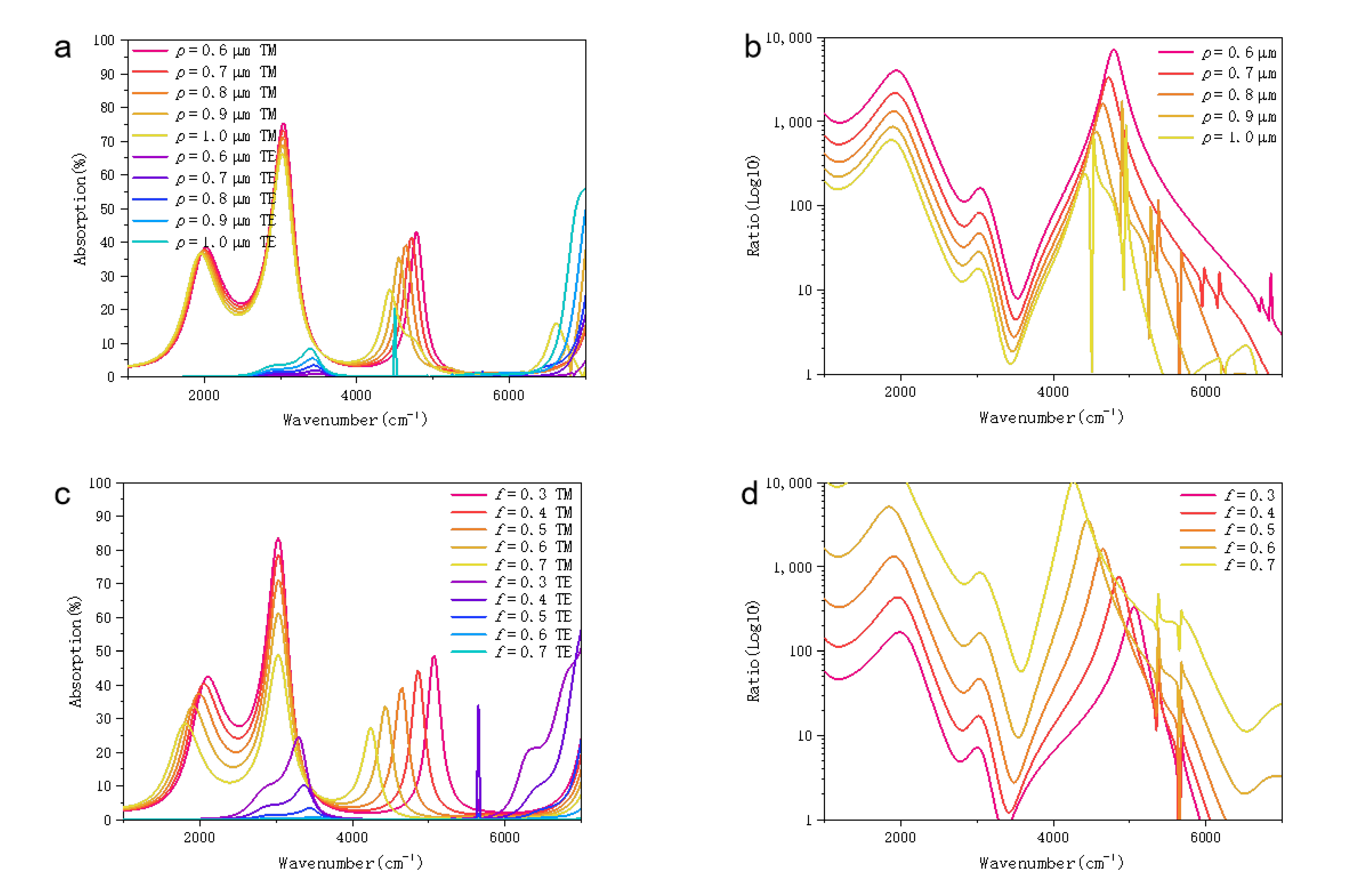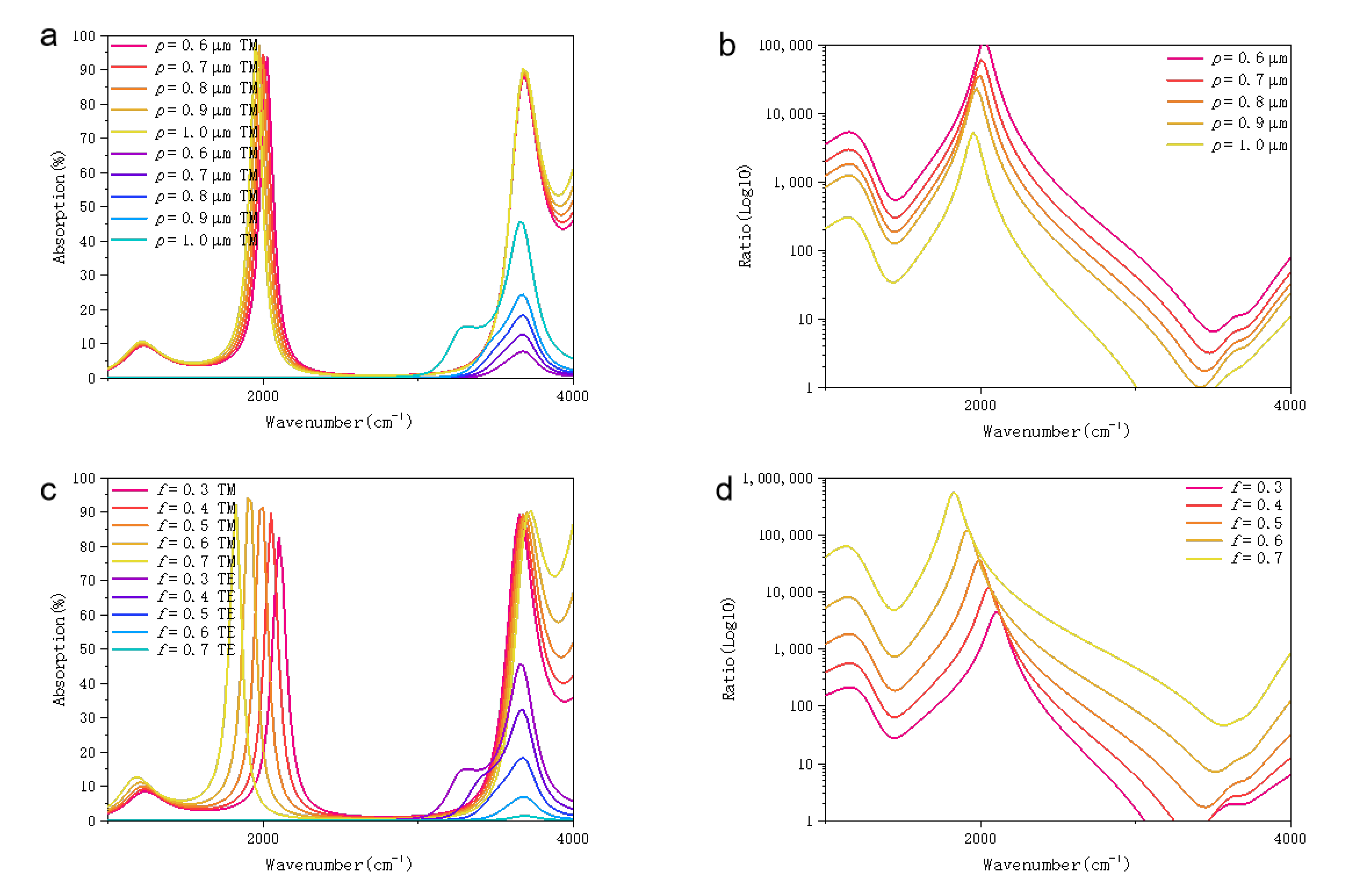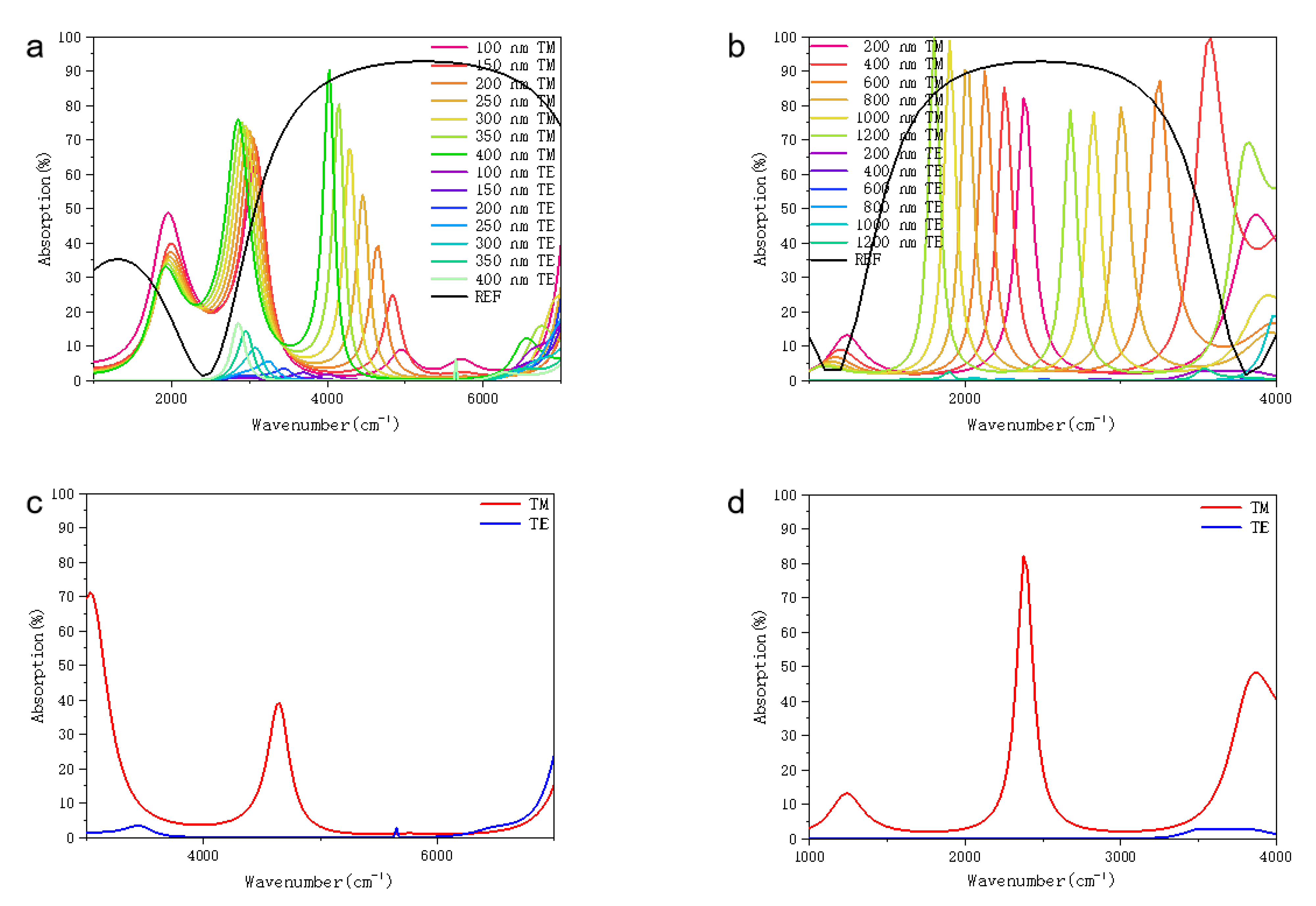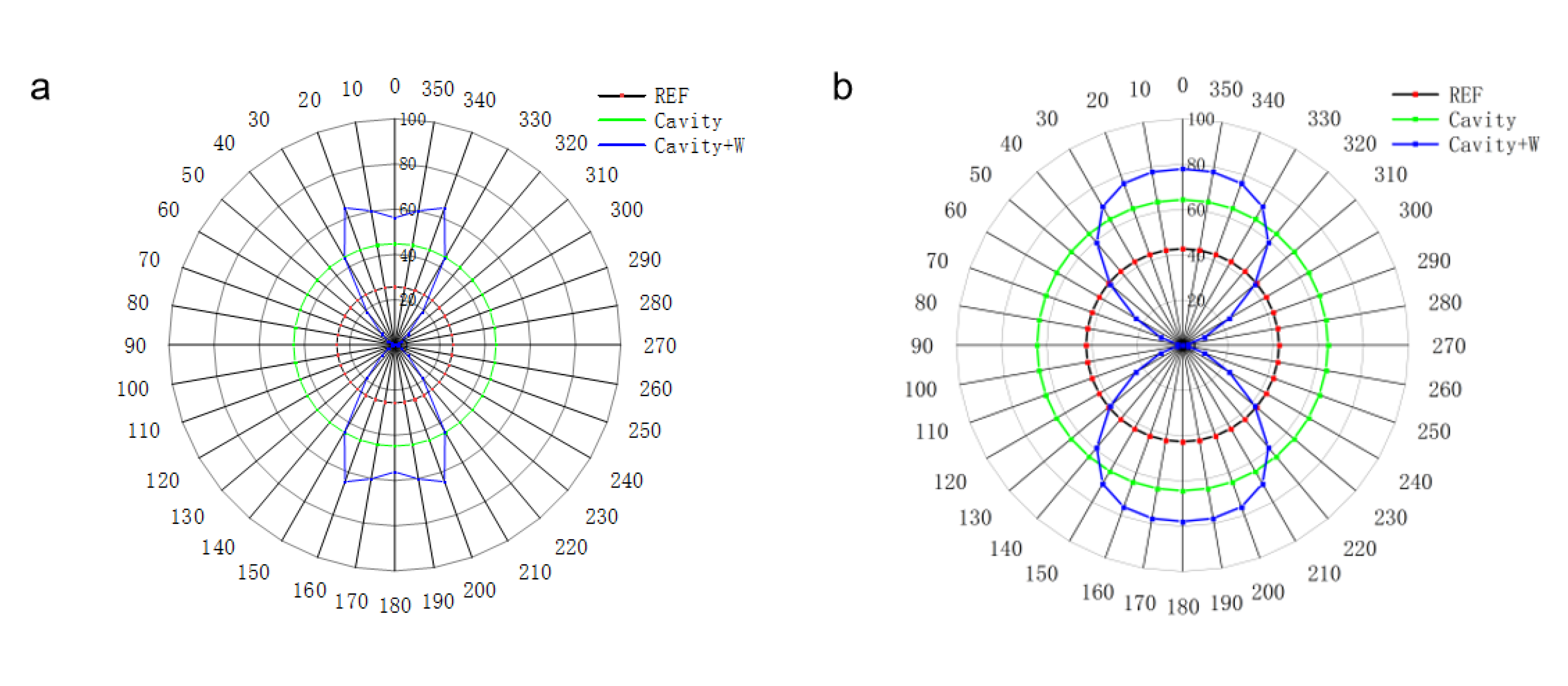Simulation of Resonant Cavity-Coupled Colloidal Quantum-Dot Detectors with Polarization Sensitivity
Abstract
:1. Introduction
2. Modeling and Simulation
3. Results and Discussions
3.1. Effects of Period and Duty Cycle
3.2. Effects of Optical Spacer Thickness
3.3. Effects of Plasmon Resonance by Wire Grid
4. Conclusions
Author Contributions
Funding
Institutional Review Board Statement
Informed Consent Statement
Data Availability Statement
Conflicts of Interest
References
- Tyo, J.S.; Goldstein, D.L.; Chenault, D.B.; Shaw, J.A. Review of Passive Imaging Polarimetry for Remote Sensing Applications. Appl Opt. 2006, 45, 5453–5469. [Google Scholar] [CrossRef] [PubMed] [Green Version]
- Van Harten, G.; Diner, D.J.; Daugherty, B.J.S.; Rheingans, B.E.; Bull, M.A.; Seidel, F.C.; Chipman, R.A.; Cairns, B.; Wasilewski, A.P.; Knobelspiesse, K.D. Calibration and validation of Airborne Multiangle SpectroPolarimetric Imager (AirMSPI) polarization measurements. Appl. Opt. 2018, 57, 4499. [Google Scholar] [CrossRef] [PubMed]
- Playle, N.; Port, D.; Rutherford, R.; Burch, I.; Almond, R. Infrared Polarisation Sensor for Forward Looking Mine Detection. In Detection and Remediation Technologies for Mines and Minelike Targets VII; SPIE: Washington, DC, USA, 2002; Volume 4742. [Google Scholar] [CrossRef]
- Rogne, T.J.; Smith, F.G.; Rice, J.E. Passive Target Detection using Polarized Components of Infrared Signatures. Proc. SPIE Int. Soc. Opt. Eng. 1990, 1317. [Google Scholar] [CrossRef]
- Cavanaugh, D.B.; Castle, K.R.; Davenport, W. Anomaly detection using the hyperspectral polarimetric imaging testbed. In Proceedings of the Algorithms and Technologies for Multispectral, Hyperspectral, and Ultraspectral Imagery XII; SPIE: Washington, DC, USA, 2006; Volume 6233, p. 62331Q. [Google Scholar] [CrossRef]
- Crosby, F.J. Stokes vector component versus elementary factor performance in a target detection algorithm. In Proceedings of the Polarization: Measurement, Analysis, and Remote Sensing VI; SPIE: Washington, DC, USA, 2004; Volume 5432, p. 1. [Google Scholar] [CrossRef]
- Liu, G.L.; Li, Y.; Cameron, B.D. Polarization-Based Optical Imaging and Processing Techniques with Application to the Cancer Diagnostics. Proc. SPIE Int. Soc. Opt. Eng. 2002, 4617. [Google Scholar] [CrossRef]
- Gupta, N.; Denes, L.; Gottlieb, M.; Suhre, D.; Kaminsky, B.; Metes, P. Spectropolarimetric Imaging Using a Field-Portable Image. Proc. SPIE Int. Soc. Opt. Eng. 2000, 4132. [Google Scholar] [CrossRef]
- Zhao, Y.; Gong, P.; Pan, Q. Object Detection by Spectropolarimeteric Imagery Fusion. IEEE Trans. Geosci. Remote Sens. 2008, 46, 3337–3345. [Google Scholar] [CrossRef]
- Ekinci, Y.; Solak, H.H.; David, C.; Sigg, H. Bilayer Al wire-grids as broadband and high-performance polarizers. Opt. Express 2006, 14, 2323. [Google Scholar] [CrossRef] [PubMed]
- Lee, K.J.; Curzan, J.; Shokooh-Saremi, M.; Magnusson, R. Resonant wideband polarizer with single silicon layer. Appl. Phys. Lett. 2011, 98, 99–102. [Google Scholar] [CrossRef]
- Yang, Z.Y.; Lu, Y.F. Broadband nanowire-grid polarizers in ultraviolet-visible-near-infrared regions. Opt. Express 2007, 15, 9510. [Google Scholar] [CrossRef] [PubMed]
- Keuleyan, S.; Lhuillier, E.; Guyot-Sionnest, P. Synthesis of colloidal HgTe quantum dots for narrow mid-IR emission and detection. J. Am. Chem. Soc. 2011, 133, 16422–16424. [Google Scholar] [CrossRef] [PubMed]
- Tang, X.; Ackerman, M.M.; Guyot-Sionnest, P. Thermal Imaging with Plasmon Resonance Enhanced HgTe Colloidal Quantum Dot Photovoltaic Devices. ACS Nano 2018, 12, 7362–7370. [Google Scholar] [CrossRef] [PubMed]
- Zhao, X.; Zhang, Y.; Zhang, Q.; Zou, B.; Schwingenschlogl, U. Transmission comb of a distributed Bragg reflector with two surface dielectric gratings. Sci. Rep. 2016, 6, 21125. [Google Scholar] [CrossRef] [PubMed]
- Ning, Y.; Zhang, S.; Hu, Y.; Hao, Q.; Tang, X. Simulation of monolithically integrated meta-lens with colloidal quantum dot infrared detectors for enhanced absorption. Coatings 2020, 10, 1218. [Google Scholar] [CrossRef]
- Tang, X.; Ackerman, M.M.; Guyot-Sionnest, P. Acquisition of Hyperspectral Data with Colloidal Quantum Dots. Laser Photonics Rev. 2019, 13, 1900165. [Google Scholar] [CrossRef]
- Wu, Z.; Powers, P.E.; Sarangan, A.M.; Zhan, Q. Optical characterization of wiregrid micropolarizers designed for infrared imaging polarimetry. Opt. Lett. 2008, 33, 1653. [Google Scholar] [CrossRef] [PubMed]
- Shirakawa, A.; Shirakawa, A.; Takaichi, K.; Takaichi, K.; Yagi, H.; Yagi, H.; Lu, J.; Lu, J.; Musha, M.; Musha, M.; et al. Diode-pumped mode-locked Yb3+;Y2O3 ceramic laser. Opt. Express 2003, 11, 2911–2916. [Google Scholar] [CrossRef] [PubMed]
- Meng, F.; Luo, G.; Maximov, I.; Montelius, L.; Chu, J.; Xu, H. Fabrication and characterization of bilayer metal wire-grid polarizer using nanoimprint lithography on flexible plastic substrate. Microelectron. Eng. 2011, 88, 3108–3112. [Google Scholar] [CrossRef]
- Kishino, K.; Unlu, M.S.; Chyi, J.-I.; Reed, J.; Arsenault, L.; Morkoc, H. Resonant cavity enhanced (RCE) photodetectors. IEEE J. Quantum Electron. 1991, 27, 2025–2034. [Google Scholar] [CrossRef]
- Motogaito, A.; Morishita, Y.; Miyake, H.; Hiramatsu, K. Extraordinary Optical Transmission Exhibited by Surface Plasmon Polaritons in a Double-Layer Wire Grid Polarizer. Plasmonics 2015, 10, 1657–1662. [Google Scholar] [CrossRef]





Publisher’s Note: MDPI stays neutral with regard to jurisdictional claims in published maps and institutional affiliations. |
© 2022 by the authors. Licensee MDPI, Basel, Switzerland. This article is an open access article distributed under the terms and conditions of the Creative Commons Attribution (CC BY) license (https://creativecommons.org/licenses/by/4.0/).
Share and Cite
Zhao, P.; Mu, G.; Chen, M.; Tang, X. Simulation of Resonant Cavity-Coupled Colloidal Quantum-Dot Detectors with Polarization Sensitivity. Coatings 2022, 12, 499. https://doi.org/10.3390/coatings12040499
Zhao P, Mu G, Chen M, Tang X. Simulation of Resonant Cavity-Coupled Colloidal Quantum-Dot Detectors with Polarization Sensitivity. Coatings. 2022; 12(4):499. https://doi.org/10.3390/coatings12040499
Chicago/Turabian StyleZhao, Pengfei, Ge Mu, Menglu Chen, and Xin Tang. 2022. "Simulation of Resonant Cavity-Coupled Colloidal Quantum-Dot Detectors with Polarization Sensitivity" Coatings 12, no. 4: 499. https://doi.org/10.3390/coatings12040499
APA StyleZhao, P., Mu, G., Chen, M., & Tang, X. (2022). Simulation of Resonant Cavity-Coupled Colloidal Quantum-Dot Detectors with Polarization Sensitivity. Coatings, 12(4), 499. https://doi.org/10.3390/coatings12040499






